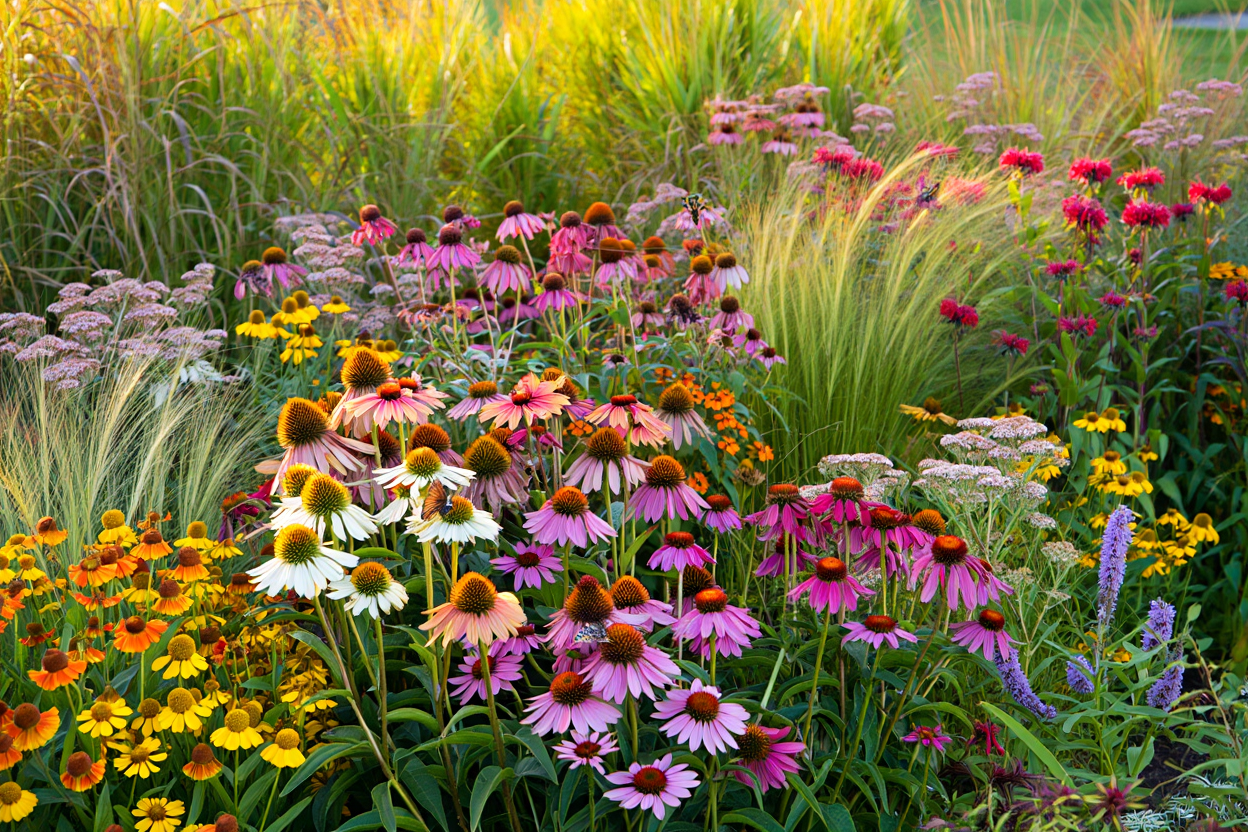
If you want a garden that looks full, blooming, and beautiful—but you don’t have the time (or patience) to wait around—fast-growing perennials are the way to go. These hardworking plants quickly fill up your beds and borders with vibrant color and lush foliage, and the best part? They come back year after year.
Most are low-maintenance, tough, and generous with their blooms. They’re perfect for covering bare spots, jumpstarting new garden areas, or just giving your space that established, full look in no time.
So which ones should you plant? Here are 15 fast-growing perennials I recommend again and again—because they will fill your space with color, charm, and plenty of pollinators, faster than you ever thought possible.
1: Black-Eyed Susan (Rudbeckia hirta)

Black-eyed Susan will grow to up to 3 feet tall (90 cm) and 2 wide (60 cm) in a matter of months. From the moment the first leaves pop out of the soil to when it blooms, it just keeps growing and growing, and by summer it will have reached full size.
And, as soon as it does, black-eyed Susan will explode in a sea of super energetic, daisy-like blossoms with a dark center, in brilliant shades of yellow, orange, red and purplish to give your garden a burst of light and warmth and attract pollinators from afar. Each flower head can be 4 inches wide (10 cm), and you will get loads from summer to early fall.
You should plant black-eyed Susan in fall, but the good news is that even if you are late, you can still sow it in spring and it will reach its full size by summer!
2: Russian Sage (Perovskia atriplicifolia)

However, Russian sage will even beat the growth speed of black-eyed Susan, as it can reach a whopping 5 feet tall (150 cm) and 4 wide (120 cm) within a single season! The upright stems, decorated with those deeply lobed leaves, will keep rising till about mid-summer, providing a very fine texture for your borders, then…
Then the long spikes with purplish-violet (or blue) little flowers will start opening and call hordes of butterflies, bees and other pollinators to your garden. And they will keep feeding on the sweet nectar of these blooms into fall – while you will enjoy their vibrant floral display.
And it will do all this from when you plant it in your garden in spring.
3: Daylily (Hemerocallis spp.)
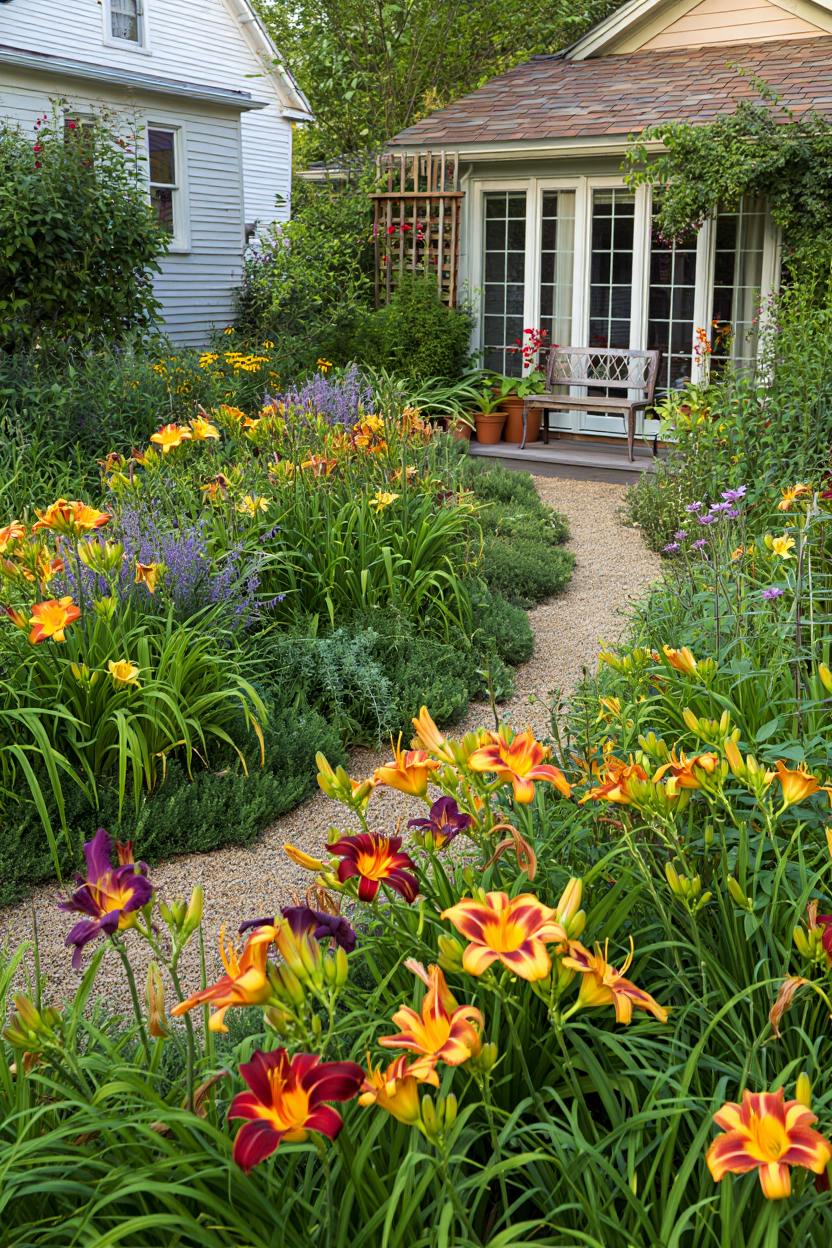
Imagine turning your yard into a lush and colorful exotic garden in a matter of months! “How can I do it,” you will wonder? Plant daylilies in fall or spring, and they will do all the rest for you! True, their blooms last a single day, but they produce so many of these amazingly colorful, super-showy blossoms, that your borders will burst with color for months.
Of course, you also get tufts of fleshy, rich green and strap-like leaves, reaching up to 4 feet tall (120 cm) and 3 feet wide (90 cm). But the main reason we love daylilies are their flowers, in a huge range of colors and combinations (there are about 100,000 varieties) and reaching quite impressive sizes. The biggest is ‘Webster’s Pink Wonder’ – 13 inches across, or 32 cm!
4: Bee Balm (Monarda didyma)
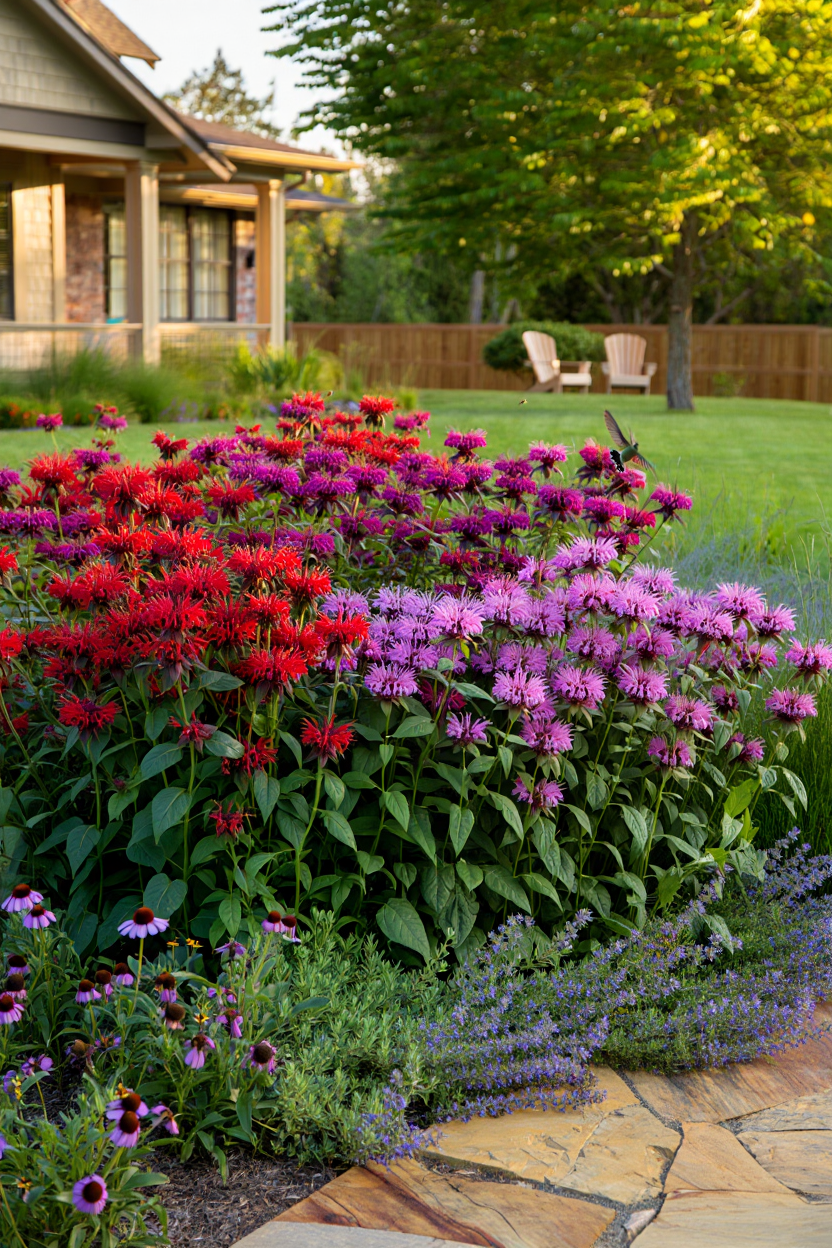
Even if it’s called bee balm, Monarda didyma is also a magnet for butterflies and hummingbirds, thanks to its round clusters of tubular flowers in purple, pink and red. But it needs to grow tall and fast to do it, so, by mid summer, it will reach up to 4 feet tall (120 cm) and 3 wide (90 cm), whether you plant it in fall or spring.
What’s more, bee balm spreads very fast, filling your borders with its lush and large leaves, which makes it an excellent choice for large gardens in a naturalistic style, or even for wild areas, why not?
5: Joe-Pye Weed (Eutrochium purpureum)
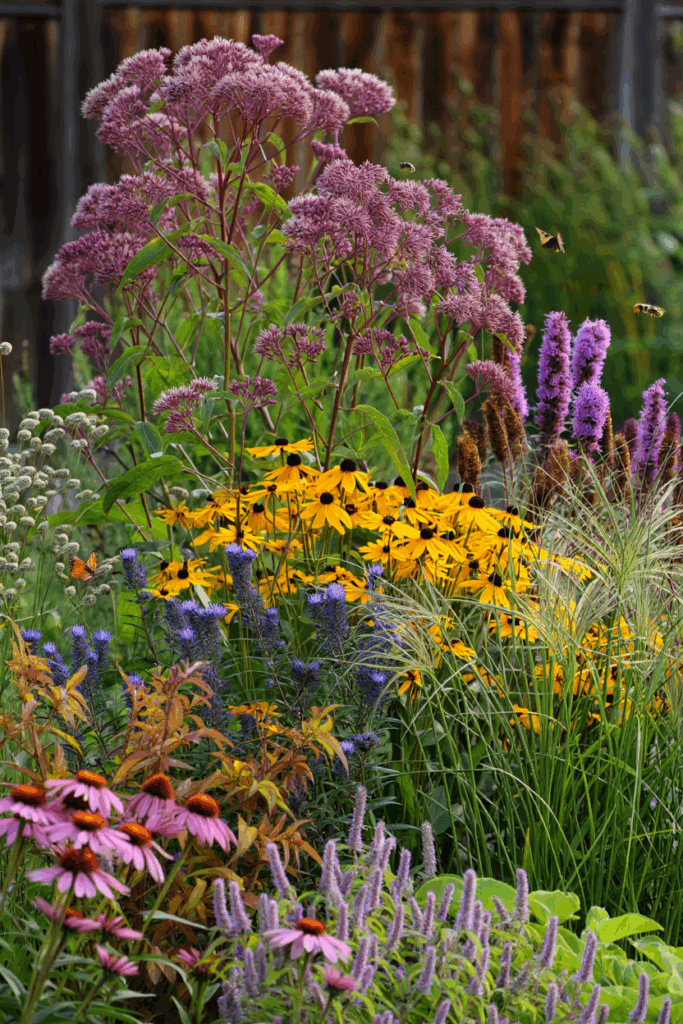
Here’s a champion of growth for you: Joe-Pye weed. Why? Depending on the variety it can reach up to a whopping 7 feet tall (120 to 210 cm) in a single season! It will “only” grow to 2 to 4 feet wide (60 to 120 cm), but in terms of height, it’s hard to beat this perennial.
And guess how long it takes it to grow that tall? From when you sow it in spring to when it blossoms in late summer (then through fall). This herbaceous perennial has long upright stems with lance shaped, dark green leaves that climb up. But at the top, it opens in round cloud-like clusters of small pinkish flowers where pollinators can land – like helipads in the sky!
6: Sneezeweed (Helenium autumnale)
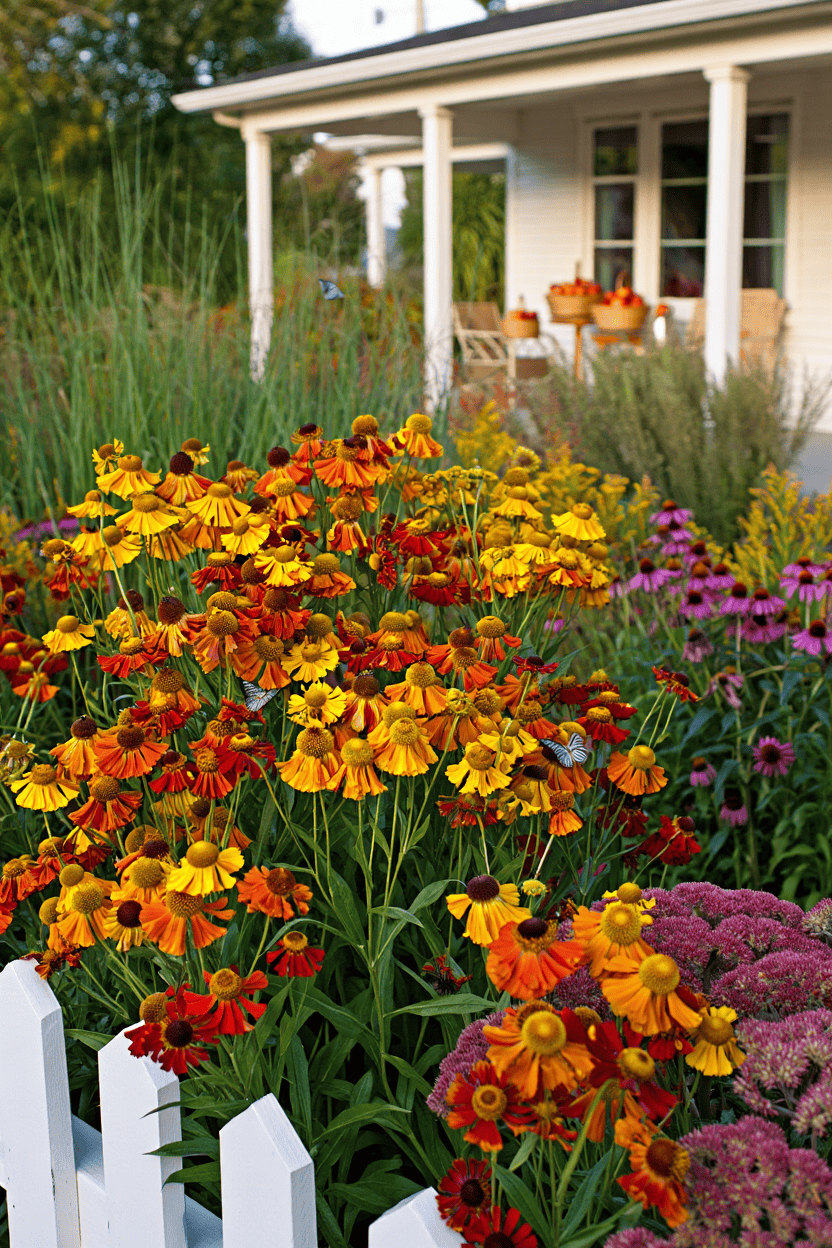
Like black-eyed Susan, sneezeweed has daisy-like flowers, but with globular centers, yellow to purple in shade, and they can open at 3 to 5 feet from ground level (120 to 150 cm). When? By late summer, so, only a few months from when you sow it in spring.
Coming in yellows, oranges, reds and purples (and in combinations), the blooms of sneezeweed are 1 to 2 inches across (2.5 to 5.0 cm), and you will get loads of them from August to fall, giving your garden a late boost of blooms and energy.
In the meantime, its lush and herbaceous leaves will have quickly filled your border, and sneezeweed is also quick to establish, and it spreads quite fast and naturally self-seeding. An ideal choice if you want lots for little work!
7: Plume Poppy (Macleaya cordata)
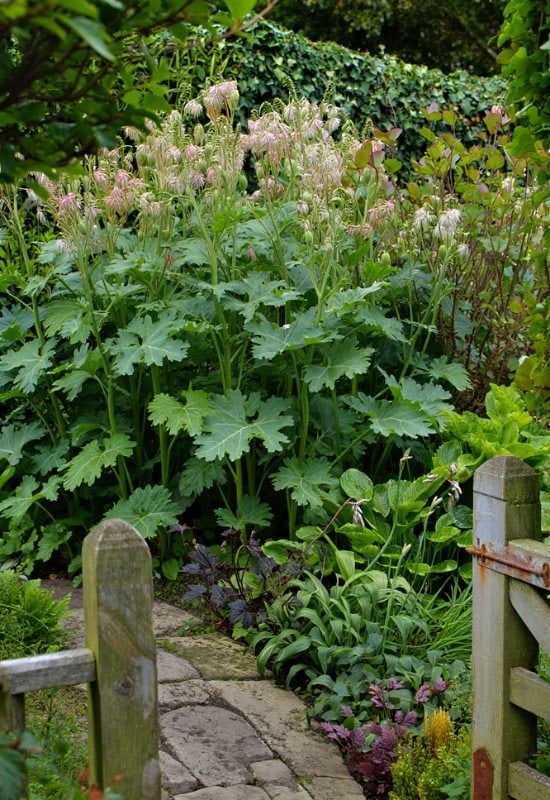
Here is a real giant for you, plume poppy! It can grow to up to 8 feet (240 cm) in a single season, and 3 feet across (90 cm). Almost everything is big about this perennial, because in the meantime, it also manages to grow massive leaves that can be 20 to 50 inches across (50 to 120 cm)! The round and lobed foliage is lush enough, but wait till July and it will give you yet another spectacle.
At the top of this fast-growing Goliath, you will see, in fact, fluffy plumes of small, down like flowers in white, pink or purplish. The flowers will last into late summer, and they offer a great contrast with the showy deeply lobed leaves.
Suitable for full Sun or partial shade, plume poppy needs a big garden to show off its giant foliage and tall feathery flowers – because it will fill any space really fast!
8: Jerusalem Artichoke (Helianthus tuberosus)
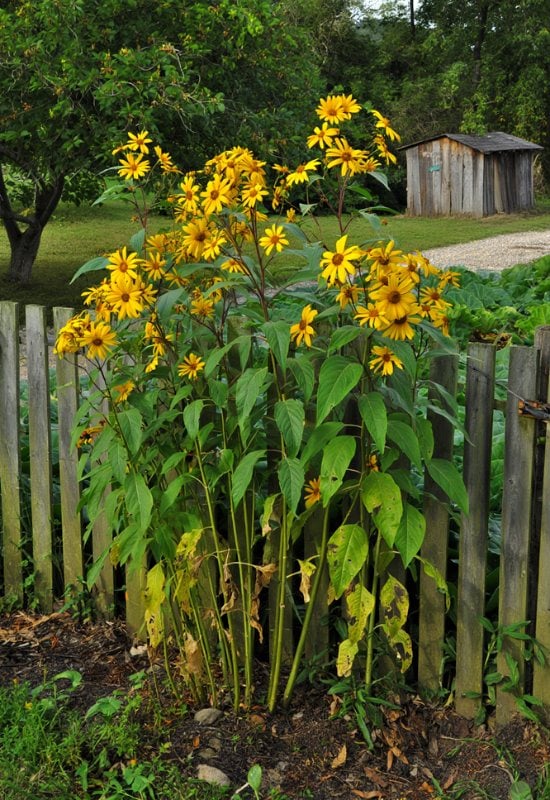
A very close relative to sunflowers (same genus), Jerusalem artichoke has smaller, but similar golden yellow flowers, up to “only” 4 inches across (10 cm). But in terms of height, this perennial has nothing to envy, as it can grow to up to 10 feet in a single season (300 cm)!
Because it produces a huge number of blossoms, you can imagine the energetic floral show it puts on from late summer to fall on top of those towering stems! You will have to cut it back at the end of the season, to half its size, but don’t worry; it will grow back very quickly next season.
It also spreads fast though, and it is fairly invasive. But there’s a solution: harvest as many tubers as you can – they are a very expensive delicacy!
9: Montbretia (Crocosmia spp.)

If you plant montbretia bulbs (actually corms) in spring, you will enjoy a massive, exotic floral display standing about 4 feet tall (120 cm) by summer, and sometimes into fall… This show of brightly colored blooms opening in succession on arching stems will be preceded by blade-like, fast growing rich green leaves, that can add an architectural dimension at the back of beds or in borders.
There are varieties in shades of yellow, orange or red, but the all-time favorite is the giant ‘Lucifer’, winner of the Award of Garden Merit by the Royal Horticultural Society, with its tubular ruby flowers that rise from a yellowish base.
And guess, what? Despite being a tropical perennial from South Africa, it is cold hardy to USDA zone 5…
10: Ravenna Grass (Saccharum ravennae)

How about a fast-growing ornamental grass? Ravenna grass is also known as giant saccharum for a reason: it can grow to a whopping 8 to 12 feet (240 to 360 cm) in a single season! And you should plant it in spring, so that growth is all achieved in a matter of about 6 months… On top of this, it can reach a spread of 6 feet (120 cm). So, you definitely need a big garden to grow it.
But if you can, you will enjoy its dense tuft of green, long and pointed leaves at the bottom and, come August, you will get towering, fluffy and dense plumes in white or purple to wave in the wind above your head. Cold hardy, it is actually semi-evergreen in USDA zone 8 and above, though you may still want to prune off the dead leaves and spent blooms.
11: Yarrow (Achillea millefolium)

Yarrow is an ideal fast-growing perennial to fill tall, natural looking borders. Yes, in fact it can grow to up to 3 feet (90 cm) in a season, depending on the variety, but there are other reasons too. The first is its finely cut, delicately textured foliage, which may persist in winter as well in USDA zones 8 and above.
The second reason is of course the large, round and flat clusters (umbels) of flowers, now available in white, yellow, orange, pink, purple, red and bicolor varieties. This flora spectacle will keep your garden ablaze with colors from early to late summer and, above all, it will offer you unusually shaped blooms that fill the tops of your borders.
12: Astilbe (Astilbe spp.)
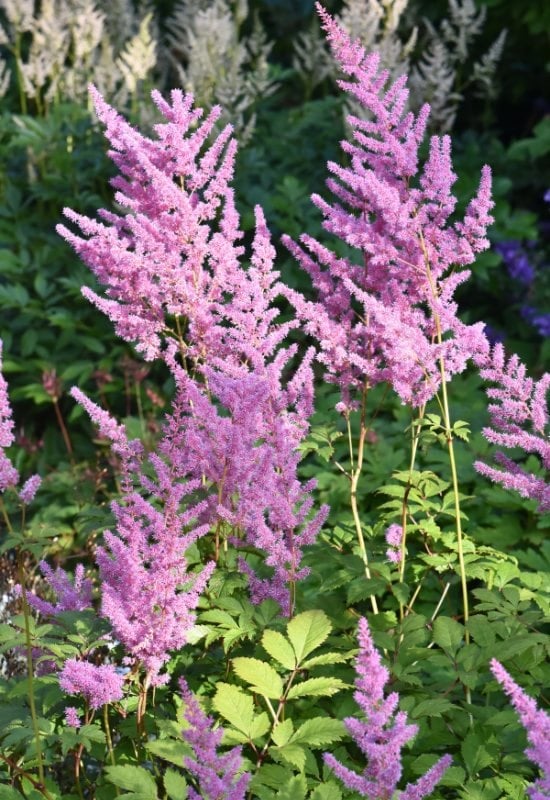
There are some dwarf varieties of astilbe, only reaching 6 inches (15 cm), but they still grow fast. On the other hand, larger varieties rise up to 5 feet (150 cm), and within a matter of months. Its lush, dense and frond-like (pinnate) foliage will start filling up your borders as soon as the season starts, and…
…You can get a very early floral display, because some varieties start flowering in late spring, while others will start in July and keep going till the end of summer. This way, you can have their colorful plumes in white, pink or purple and with different shapes in your garden for months and months on end, and very fast indeed.
13: Plantain Lily (Hosta spp.)
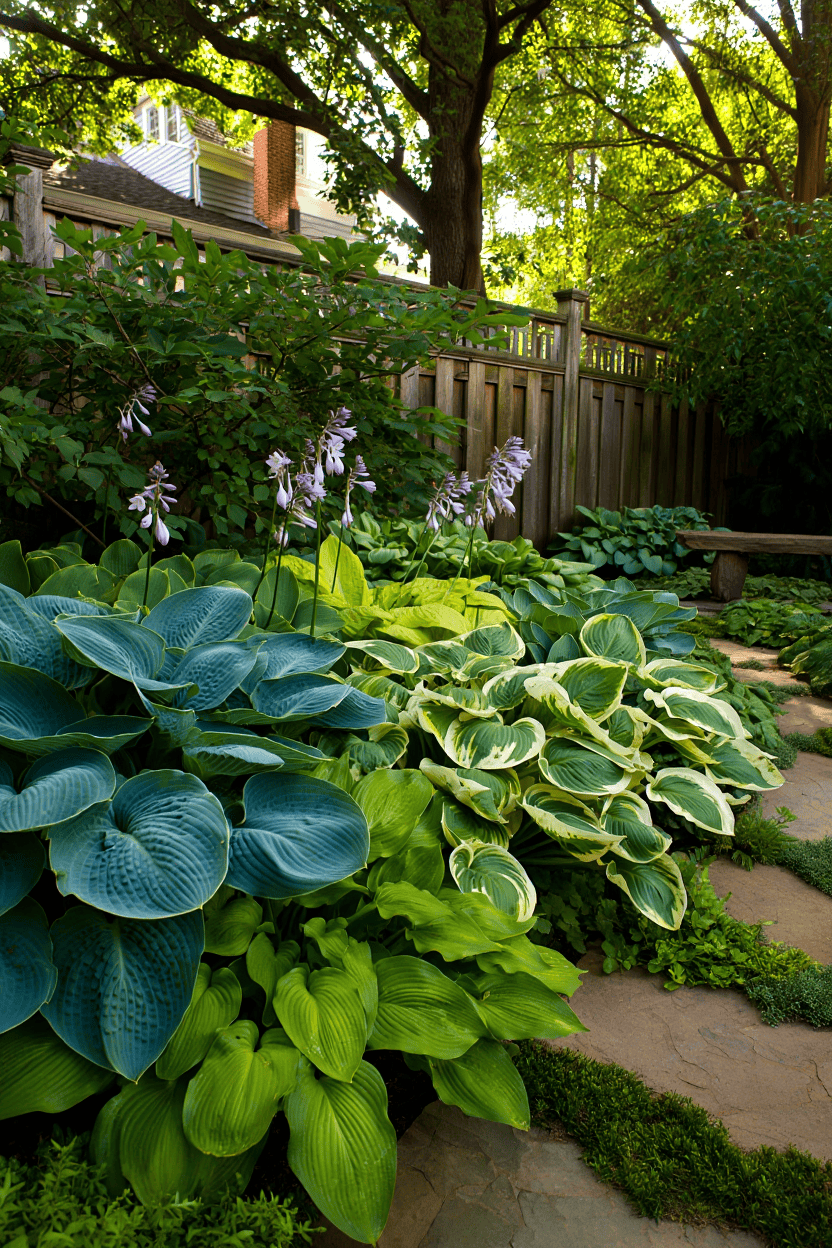
You wouldn’t think that Hosta, a.k.a. plantain lily is a fast-growing perennial, would you? But it is! In fact, it grows back every single year, and these leafy beauties can reach quite considerable sizes, up to 4 feet tall (120 cm) and 6 feet wide (180 cm) in a single season!
Needless to say, plantain lilies will fill shady areas of your garden, with their gorgeous green, but also bluish, yellow, white and variegated leaves through the season, and they will reach their full size by summer. In fact, by that time, they will be ready to produce those lovely spikes of white or purple, trumpet-shaped flowers that hover above the leafy cushion on the ground.
Just keep slugs and snails away!
14: Coneflower (Echinacea spp.)
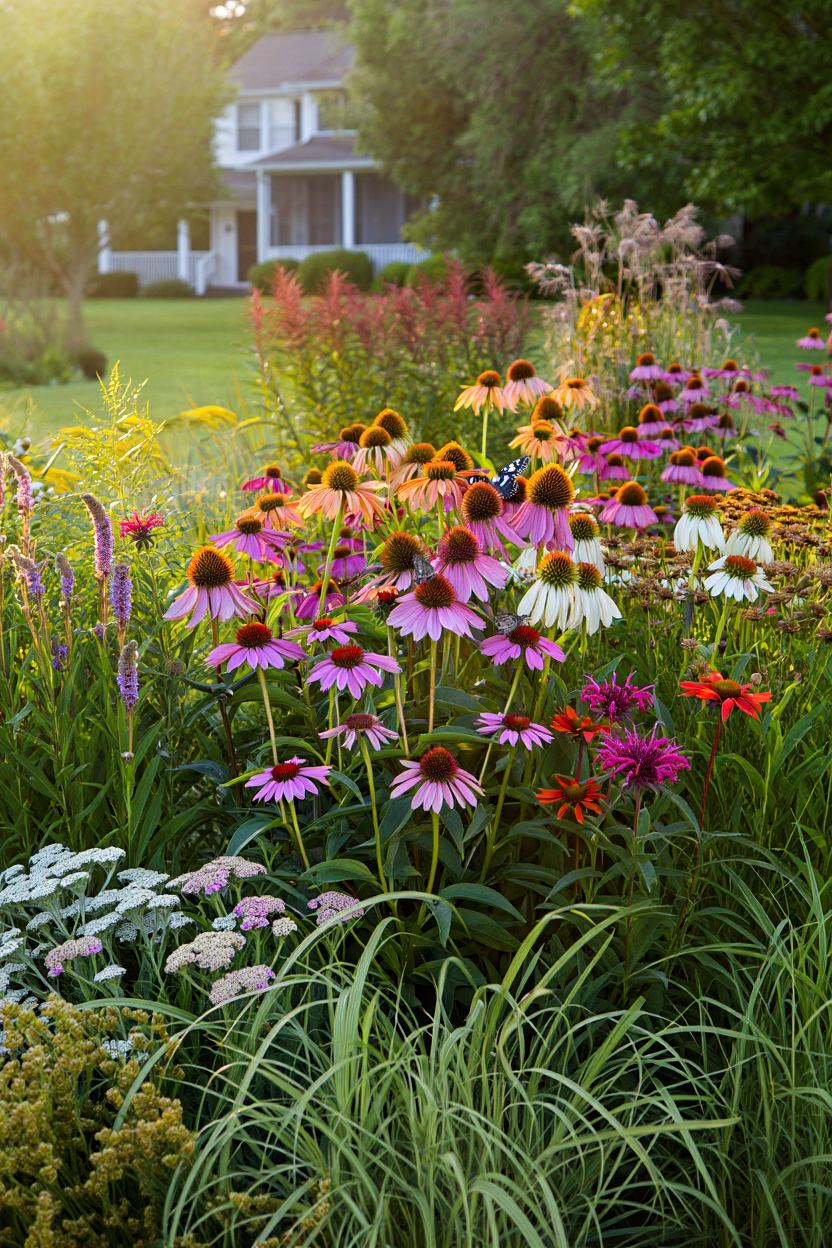
Coneflower is yet another perennial we all love, and that will grow to its full size, up to 4 feet tall (120 cm) and 2 wide (60 cm) in a single season. At first, it will produce its broad, showy and rough-looking leaves at the base, then, smaller ones will accompany the stems higher up -and up, and up until….
…By early summer you will see the first buds, which will open in July and start attracting hordes of butterflies, bees and pollinators to your garden with their vibrant warm colors and large size! These daisy-like blooms with a “dome” in the middle will keep opening till September (or beyond in warmer climates), and you can leave them on in winter to feed wildlife.
Or you can cut the plant back to the basal rosette to keep your garden tidy – don’t worry; it will grow back as big and strong next year!
15: Japanese Anemone (Anemone hupehensis)

Bushy, somewhat wild-looking but gracious at the same time, Japanese anemone can grow to 3 feet tall and in spread (90 cm) in a single season, like the other perennials I have selected. The finely textured, rich green, cut foliage it produces is decorative enough to justify its presence in your borders and garden – it fills space with delicate but vigorous elegance. However…
The whole show peaks in late summer and fall, when Japanese anemone fills with broad petaled, white to pink flowers with a golden center, that seem to fly on top of the leafy mound, looking in all direction, for you to admire them from every angle and pollinators to reach them from everywhere.
Cut it back before winter and it will grow back even more vigorous next year!
Fast-Growing Perennials for a Garden Full of Blooms and Foliage – and Quick!
So, now you know these 15 fast growing perennials, no more gaps in your beds and borders next year. Your garden will be leafy and full of blooms all through the season!

Written By
Amber Noyes
Amber Noyes was born and raised in a suburban California town, San Mateo. She holds a master’s degree in horticulture from the University of California as well as a BS in Biology from the University of San Francisco. With experience working on an organic farm, water conservation research, farmers’ markets, and plant nursery, she understands what makes plants thrive and how we can better understand the connection between microclimate and plant health. When she’s not on the land, Amber loves informing people of new ideas/things related to gardening, especially organic gardening, houseplants, and growing plants in a small space.
